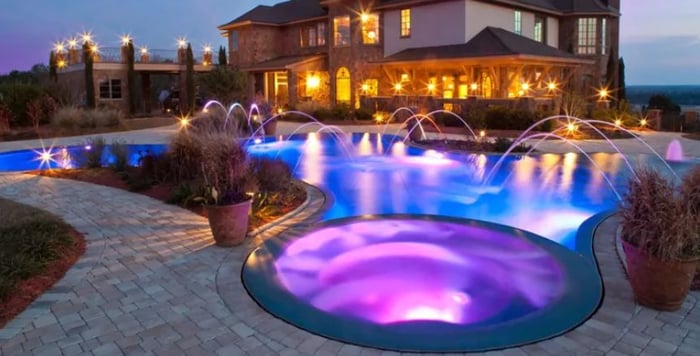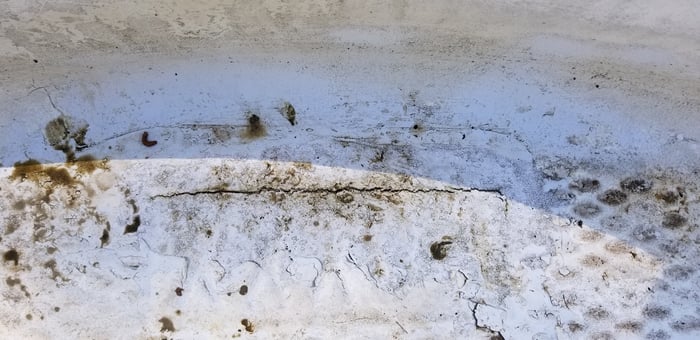Finding a Leak in your vinyl pool can be a difficult task but we have some steps to follow that will make it much easier to find out if you have one!
Step One: Perform a Bucket Test
The bucket Test will determine if your pool is actually leaking or if it is simply evaporation.
- Take a 5-gallon bucket, fill it 2/3rds full with water, and mark the water level with a piece of tape or a pencil.
- Mark the water level in the pool as well on the faceplate of the skimmer.
- Place the bucket at poolside or on the steps of the pool.
- Wait 24 hours and then check the water loss in the bucket versus the pool. If the loss is the same, more than likely the water loss is evaporation. If the water loss is different, this would indicate a leak in the pool.
Step Two: Determine How Much Water the Pool is Losing
Fill the pool to the proper operating level and mark the water level with tape, pencil or crayon. Record the loss in 1/4 of inches, once in the morning and once in the evening for 24 to 48 hrs with the system on. Once measurements are gathered, repeat the same procedure with the pool turned off. More water loss with pool system on, in most cases points to a leak in the plumbing or equipment.
As a rule of thumb, losses up to 1/2 inch daily may indicate a combination of evaporation/ wind/splash out. Losses up to 1 inch daily more than likely indicate a leak somewhere in the system, more than 2 inches of water loss per day would normally be caused by a broken pipe, broken or loose fitting, equipment (especially with a sand filter) or by a visible hole or tear in the liner.
Cause 1: "Splash out" is lost through various activities in the pool including diving, water games, etc.
- Observation: Fill pool to operating level. If the water level does not drop on days pool is not used, splash out is the cause.
- Cure: Warn pool users that splash out is the cause
Cause 2: The loss of 1/4" (up to 1/2" during excessively hot or dry periods) of pool water per day is an indication of water loose due to evaporation.
- Observation: Loss of water to evaporation will be noticeable in the morning as cooler night air causes a higher rate of evaporation than hot sunlight. Wind also contributes to evaporation.
- Cure: A solar cover placed on the pool at night will reduce nighttime evaporation by as much as 90%.
Cause 3: Filtration/Plumbing System. If splash out and evaporation have been eliminated as probable causes of water loss, the next step is to check the filter/plumbing system.
- Observation: If water loss continues, the leak may be in one of the wall fittings, such as an inlet, skimmer, underwater light, main drain or stair strips. Us a dye, such as phenol red of a test kit or red food coloring. With the filter turned off, use dye in the suspected area and observe if it is drawn into the leak.
- Cure A: Check the pipe/hose connections at valves, filter and pump for leaks. If none are found:
- Cure B: Shut down the filter and plug the skimmer, main drain, and all inlets. If water loss ceases, there is leakage somewhere in the piping. Check the lines by pressure testing them. This can be done by your local pool professional.
- Cure C: Allow water level to drop until it stops at either a tear in the liner or at one of the wall fittings, to indicate the leak is there. However, if the water continues to drop below the fittings or light cut-out add water to the pool to maintain pressure on the walls. The leak is at or below the low water level somewhere in the liner.
Cause 4: The liner. To locate a small hole in the liner will require someone with diving apparatus to search underwater for the hole. It is important that the pool be operational so the water is absolutely clear for the diver.
- Observation: Check the entire pool bottom starting at the liner seams and corners. If a particular area is suspect, the leak can be verified using a dye, such as the phenol red of a test kit or red food coloring, in the area and observing if it is drawn into the hole. You can use a syringe with the red food color to isolate the dye when looking at suspicious places. The syringe can be picked up at the local pet store, co-op, or Amazon.
- Cure: There are a number of underwater adhesives designed for patching vinyl liners without draining the pool; follow the manufacturer's instructions.





